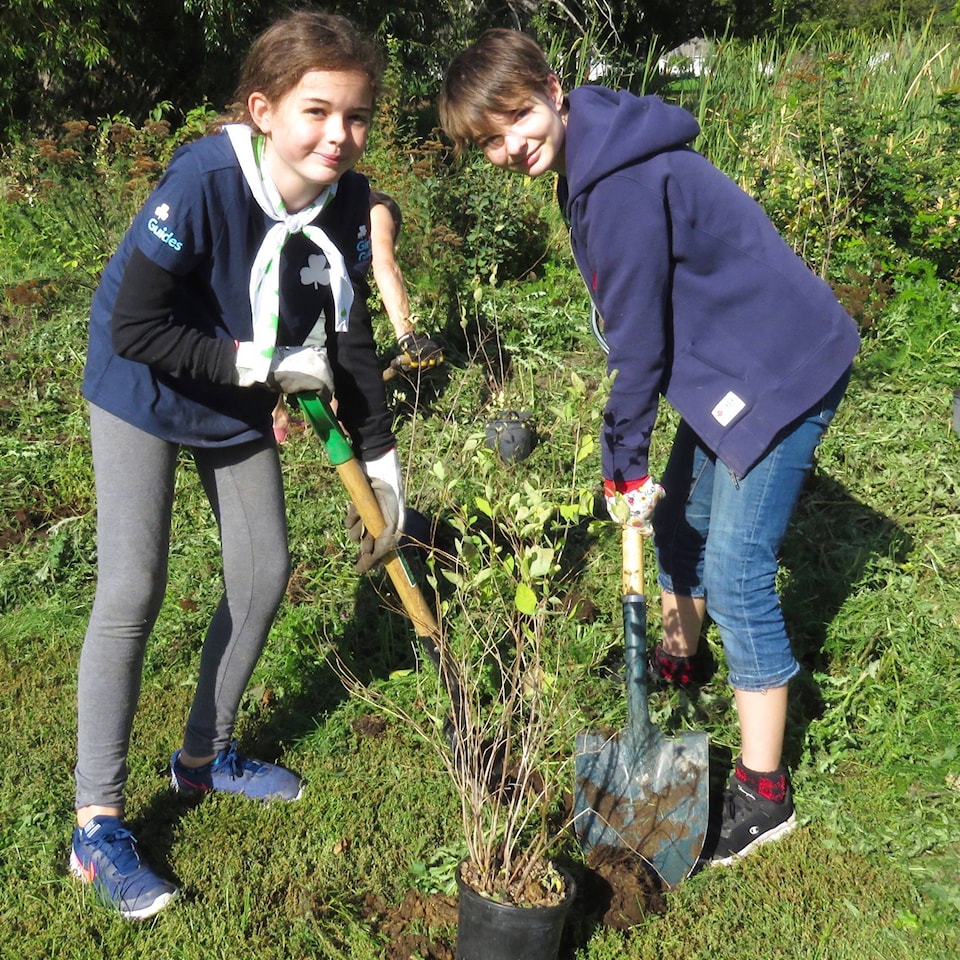I don’t know about you, but the names of these eight plants native to the South Okanagan read like poetry for me.
Nootka rose, common snowberry, Canada goldenrod, blue elderberry, red osier dogwood, Saskatoon/serviceberry, chokecherry and sandbar willow.
On a late September morning this fall, three hundred of these hardy Okanagan-loving plants were re-introduced to their native environment. With the help of about two-dozen volunteers, they were popped out of their incubator pots, tangled roots fluffed, gently placed into freshly dug holes, then back-filled and firmly tamped in.
Within a couple of hours, all the plants had found new homes along the wetland verge between Coyote Cruises and Loco Landing just south of the Okanagan River Dam.
With enthusiastic gardeners, including six members of First Coyote Hills Guide troop and some moms, the work went so quickly a protective topcoat of mulch was added before noon!
This is another successful project for the Okanagan Similkameen Stewardship Society, one of the excellent organizations helping us preserve, protect and enhance our Okanagan and Similkameen valleys.
I’m glad I played a small part in this particular planting. With a camera, notebook and shovel in hand, I managed to plant a common snowberry here, a Nootka rose a few feet away, and at least half a dozen more. I’d like to think I planted well and got some good exercise.
Additional bonus; a multitude of birds sang from the ancient wetland cottonwoods that overlooked our endeavour.
Pleased with the volunteer turnout and our quick work, Alyson Skinner, the OSS executive director, grinned happily as buckets and tools were dropped into bins for the trip home. “It’s great to have this kind of community involvement,” Alyson told me. “It helps get the plants in the ground and helps with the overall success of the planting.”
That’s good to hear. “There’s less littering and more appreciation, more care for these natural areas. Those that helped today continue to drop by to keep an eye on things.”
The planters also have a greater understanding of the importance of these fragile pockets of wet that help filter pollutants and provide protective habitat. The work of the OSS intrigued me since I first encountered one of their outreach info booths a few years ago. I’ve even stumbled upon several of their previous work parties where I helped eradicate burdock, a disturbed soils opportunist that overwhelms native shrubs along the road to Max Lake.
The main focus of OSS, however, is to “promote voluntary conservation,” by developing partnerships on public and private lands to enhance key habitats. The preferred word here is stewardship.
I like that word. It evokes a caring sensibility, a committed safekeeping with an attentive and responsible approach to natural environments.
In talking to Lia McKinnon, OSS field biologist, Lia said stewardship is a growing enterprise. She pointed to a map with a multitude of large dots sprinkled between Vernon and Osoyoos.
“Here’s what OSS is all about. These dots represent the people who have joined our nature stewardship program.” The surprising clutter of dots indicated a notable involvement.
“You’re right,” Lia confirmed. “When I first started with the program, there were only a few committed wildlife habitat stewards. Now there are almost one hundred stewardship partners.”
These nature stewardships are vigorously supported by OSS with information on native plants and wildlife, help with land management issues and habitat enhancement.
In addition, OSS produces valuable information resources. I’m proud to have one of my photographs in their Bighorn Sheep brochure. Now I know how to help Bighorn Sheep — by avoiding their territory, especially during spring lambing and fall mating season.
What about amphibians? Cleverly-titled handout Puddles for Peepers shares fascinating photos of salamanders, frogs and toads amidst tips to protect their pond and puddle habitats.
Would you like to make your property more nature-friendly? Be a nature steward. Visit the OSS website at www.osstewardship.ca.
Dianne Bersea is a member of South Okanagan Naturalists. Views expressed do not necessarily represent SONC. www.southokanagannature.com
